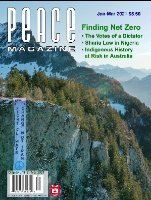
Peace Magazine Jan-Mar 2021, page 2. Some rights reserved.
In the early 1800s, the people now known as the Rohingya were brought from British-controlled Bengal—now independent Bangladesh—to the lands which currently comprise Rakhine State in Myanmar.
When Burma achieved independence in 1948, the Rohingya were granted citizenship, but in 1982 the military government in Burma took it away.
In 2013, when conflict broke out in Rakhine, 110,000 Rohingya ended up in an internally displaced persons camp.
Large-scale fighting broke out in 2017 and the Burmese army raped and slaughtered thousands of men, women, and children. Approximately 700,000 Rohingya fled to Bangladesh, Many have been living in Cox’s Bazar, the largest refugee camp in the world.
In 2019 Gambia charged Myanmar with genocide before the International Court of Justice (ICJ). Aung San Suu Kyi, previously lauded for her defence of human rights, had by then become the country’s primary de facto political leader.
Suu Kyi denies the current charges. The ICJ case will last for years. In January 2020, provisional measures were impose on the Myanmar government. It is clear, however, that Myanmar is not complying; indeed, the genocide against the Rohingya is continuing.
Bangladesh, one of the world’s most overcrowded countries, has not forced any Rohingya to return to Myanmar. It has, however, prepared a settlement on an island—Bhasan Char, about four hours from the mainland—where it is relocating some of the refugees.
In recent weeks, there have been formal accusations that some Rohingya are being moved to Bhasan Char involuntarily. The island has been described as “prison-like” and people are not allowed freedom of movement there.
Thomas Andrew, the UN’s Special Rapporteur on the Situation of Human Rights in Myanmar, blames Myanmar for this situation, but urges the international community to take on more of the burden of supporting the refugees until they can safely return to their homes in Rakhine.
source: standup4humanrights.org
“I have committed my life to the abolition of nuclear weapons.
I have nothing but gratitude for all who have worked for the success of our treaty.”
—Setsuko Thurlow, International nuclear disarmament advocate and survivor of the atomic bombing of Hiroshima.
The UN Treaty on the Prohibition of Nuclear Weapons (TPNW) is “our treaty”.
The TPNW is built upon decades of anti-nuclear activism that led to the 2007 launch of the International Campaign to Abolish Nuclear Weapons (ICAN). ICAN brought together diverse groups and involved youth in the conversation; civil society then engaged directly with governments on the humanitarian impacts of nuclear weapons.
On 7 July 2017, 122 nations adopted the TPNW. Absent were the nuclear weapons states and their nuclear umbrella allies, including Canada; leadership came from smaller non-nuclear states that withstood immense pressure from nuclear powers and committed to signing and ratifying the treaty.
Honduras followed Jamaica and Nauru by ratifying the TPNW on 24 October 2020, fulfilling the 50-nation requirement for the next step toward nuclear disarmament—the treaty comes into force on 22 January 2021.
Canada has never been supportive of the TPNW but its previous dismissive attitude toward the TPNW is giving way to acknowledgement. Canada’s peace community, however, is joining forces in outreach and education to bring the TPNW to Canada.
The TPNW Action Group is a loose coalition that shares ideas, collaborates, and combines resources to maximize their impact as the treaty comes into force. Contact Melissa Whaling (missywhaling@gmail.com) to find out how you or your local peace, environmental or community group can connect with the TPNW Action Group to share, support or participate. Every signature, every letter, every voice is essential.
Source: Vinay Jindal MD
Co-chair, Toronto’s Hiroshima Nagasaki Day Coalition (HNDC)
Acting president, International Physicians for the Prevention of Nuclear War Canada (IPPNWC)